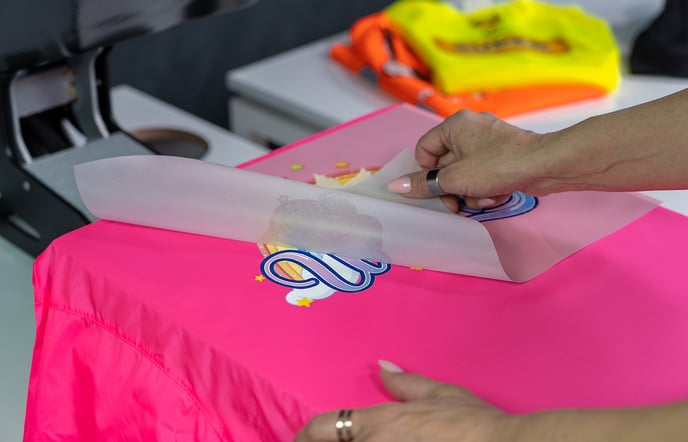A Deep Dive into DTF Printing: Techniques, Benefits, and Industry Applications
A Deep Dive into DTF Printing: Techniques, Benefits, and Industry Applications
Blog Article
Understanding DTF Printing: Tips and Tricks for Getting Vibrant and Resilient Prints
Worldwide of textile printing, achieving long lasting and vibrant prints is a desired ability that can elevate the high quality of your output. Grasping DTF (Straight to Movie) printing requires a blend of technological knowledge, precision, and interest to information. From selecting the best products to make improvements print settings and improving post-printing ending up techniques, there are various variables that can affect the outcome of your prints. Comprehending exactly how to browse these ins and outs can make all the difference between a mediocre result and a genuinely exceptional one.

DTF Printing Fundamentals
For those brand-new to the world of textile printing, understanding the principles of DTF printing is essential to understanding this cutting-edge method. Direct to Film (DTF) printing is a modern-day approach that includes transferring layouts from an unique film onto various textiles using a warm press. Unlike traditional approaches like display printing, DTF provides advantages such as vivid colors, complex outlining, and the ability to publish on diverse materials like cotton, polyester, and blends.
The procedure begins by publishing the style on a special DTF movie making use of a compatible printer with CMYK or CMYKW ink collections. When the design is published, it is then healed with a warm press to develop a long-lasting and long lasting print. DTF printing is known for its capacity to recreate intricate styles with high precision and shade accuracy, making it a preferred choice for organizations wanting to develop customized garments, marketing items, and a lot more.
Choosing the Right Materials

The adhesive powder acts as a bonding representative between the printed style and the material, so it should have strong adhesion properties to ensure a sturdy and resilient transfer. By carefully choosing the ideal materials for DTF printing, printers can enhance the top quality, vibrancy, and durability of their prints.
Optimizing Publish Settings
When intending to accomplish the finest outcomes in DTF printing, careful attention to maximizing print settings is crucial for making certain top quality and specific transfers onto textiles. When enhancing print setups is the resolution, one crucial aspect to think about. Higher resolutions normally result in sharper and a lot more detailed prints, improving the total quality of the transfer. In addition, adjusting the ink thickness can aid make certain and achieve lively colors that the try this out layout stands apart on the textile.
While raising the rate can boost performance, it may endanger the final print's quality and shade saturation. Experimenting with various rates and observing the outcomes can help identify the ideal setting for each print job.
Furthermore, fine-tuning shade accounts and making sure appropriate color administration are vital for accomplishing accurate and consistent colors throughout various prints. By calibrating color settings and accounts, printers can lessen color discrepancies and produce consistent results, enhancing the total print high quality and client complete satisfaction.
Preparing Artwork for DTF Printing
To make certain ideal cause DTF printing, thorough interest to detail is crucial when preparing art work for transfer onto textiles. Begin by selecting high-resolution photos to maintain quality and sharpness in the last print. Vector graphics are liked as they can be easily scaled without shedding top quality. Transform the artwork to CMYK shade mode to make sure that the colors convert accurately from display to print. Adjust the color degrees and comparison as required to enhance the vibrancy of the style. When including text to blog the art work, choose typefaces that are suitable and readable for the intended size. Bear in mind to mirror the final style prior to printing to make certain that it transfers appropriately onto the garment. Additionally, think about the fabric type and shade when picking the artwork, as these aspects can influence the final look. By following these steps and paying attention to the details, you can prepare artwork that is enhanced for vibrant and resilient DTF prints.
Post-Printing Finishing Strategies
Applying reliable post-printing ending up methods is important to boosting the toughness and visual appeal of DTF prints on fabrics. When the printing procedure is total, applying heat to the published layout is vital.
Once the film is eliminated, the print may need added curing time to further establish the ink into the textile. This action helps boost the washability and resilience of the print, guaranteeing it can endure several laundry cycles without fading or breaking.
Additionally, cutting any kind of excess movie around the style can provide the last print a tidy and professional appearance. Making the effort to properly complete DTF prints post-printing can significantly influence the overall top quality and site link durability of the fabric design.

Final Thought
To conclude, mastering DTF printing calls for an extensive understanding of the basics, choosing appropriate products, optimizing print settings, preparing artwork successfully, and making use of post-printing finishing methods. By complying with these tricks and suggestions, one can accomplish vivid and durable prints that fulfill their preferred top quality requirements. Regular technique and attention to detail are necessary in achieving successful outcomes in DTF printing.
From selecting the right materials to fine-tuning print settings and refining post-printing finishing techniques, there are many factors that can influence the outcome of your prints. Unlike traditional methods like display printing, DTF supplies benefits such as vivid shades, complex outlining, and the capability to print on diverse materials like cotton, polyester, and blends.
As soon as the layout is published, it is then cured with a heat press to develop a sturdy and long-lasting print.When intending to attain the finest results in DTF printing, meticulous focus to enhancing print settings is essential for ensuring precise and high-quality transfers onto textiles.In verdict, understanding DTF printing needs a comprehensive understanding of the essentials, choosing suitable products, maximizing print settings, preparing art work successfully, and utilizing post-printing ending up techniques.
Report this page